The Multivariable Alexander Polynomial: Difference between revisions
No edit summary |
DrorsRobot (talk | contribs) No edit summary |
||
| Line 52: | Line 52: | ||
{{InOut| |
{{InOut| |
||
n = 5 | |
n = 5 | |
||
in = <nowiki>mva - (mva /. {t1->t2, t2->t1})</nowiki> | |
in = <nowiki>Simplify[mva - (mva /. {t1->t2, t2->t1})]</nowiki> | |
||
out= <nowiki> |
out= <nowiki> (t1 - t2) (t3 - t4) |
||
----------------------------------- |
|||
| ⚫ | |||
t2 t4 - t1 t2 t4 + t3 t4 - t1 t3 t4 - t2 t3 t4) / |
|||
(Sqrt[t1] Sqrt[t2] Sqrt[t3] Sqrt[t4])) + |
|||
(-t1 - t2 + t1 t2 - t3 + 2 t1 t3 + t2 t3 - t1 t2 t3 - t4 + t1 t4 + |
|||
2 t2 t4 - t1 t2 t4 + t3 t4 - t1 t3 t4 - t2 t3 t4) / |
|||
| ⚫ | |||
<!--END--> |
<!--END--> |
||
Revision as of 11:18, 21 April 2009
(For In[1] see Setup)
|
| ||||||||
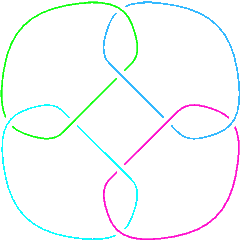 L8a21 |
The link L8a21 is symmetric under cyclic permutations of its components but not under interchanging two adjacent components. It is amusing to see how this is reflected in its multivariable Alexander polynomial:
In[3]:=
|
mva = MultivariableAlexander[Link[8, Alternating, 21]][t] /. {
t[1] -> t1, t[2] -> t2, t[3] -> t4, t[4] -> t3
}
|
Out[3]=
|
(-t1 - t2 + t1 t2 - t3 + 2 t1 t3 + t2 t3 - t1 t2 t3 - t4 + t1 t4 +
2 t2 t4 - t1 t2 t4 + t3 t4 - t1 t3 t4 - t2 t3 t4) /
(Sqrt[t1] Sqrt[t2] Sqrt[t3] Sqrt[t4])
|
In[4]:=
|
mva - (mva /. {t1->t2, t2->t3, t3->t4, t4->t1})
|
Out[4]=
|
0
|
In[5]:=
|
Simplify[mva - (mva /. {t1->t2, t2->t1})]
|
Out[5]=
|
(t1 - t2) (t3 - t4)
-----------------------------------
Sqrt[t1] Sqrt[t2] Sqrt[t3] Sqrt[t4]
|
But notice the funny labelling of the components! At the moment there is no way to tell MultivariableAlexander which variable is to be associated with what variable so MultivariableAlexander chooses an arbitrary ordering of tha variables. Hence we had to rename t[3] to be t4 and t[4] to be t3.
(To be precise, MultivariableAlexander orders the components so that its output would be lexicographically minimal among all possible orderings. This way it is at least guaranteed that different presentations for the same link will yield the same output for MultivariableAlexander.)
Links with Vanishing Multivariable Alexander Polynomial
There are 11 links with up to 11 crossings whose multivariable Alexander polynomial is . Here they are:
In[6]:=
|
Select[AllLinks[], (MultivariableAlexander[#][t] == 0) &]
|
Out[6]=
|
{Link[9, NonAlternating, 27], Link[10, NonAlternating, 32],
Link[10, NonAlternating, 36], Link[10, NonAlternating, 107],
Link[11, NonAlternating, 244], Link[11, NonAlternating, 247],
Link[11, NonAlternating, 334], Link[11, NonAlternating, 381],
Link[11, NonAlternating, 396], Link[11, NonAlternating, 404],
Link[11, NonAlternating, 406]}
|
 L9n27 |
 L10n32 |
 L10n36 |
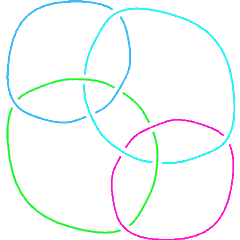 L10n107 |
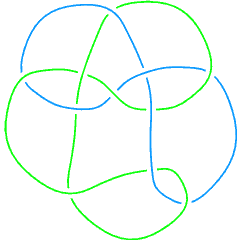 L11n244 |
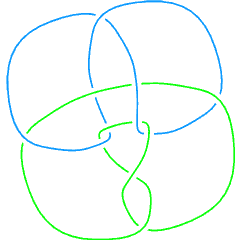 L11n247 |
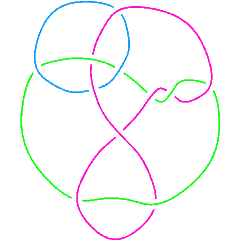 L11n334 |
 L11n381 |
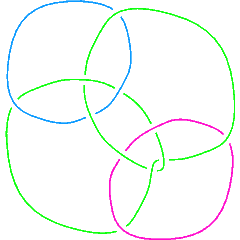 L11n396 |
 L11n404 |
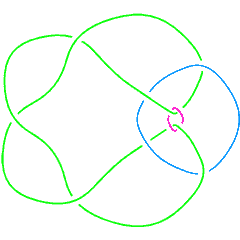 L11n406 |
Dror doesn't understand the multivariable Alexander polynomial well enough to give simple topological reasons for the vanishing of the said polynomial for these knots. (Though see the Talk Page).
Detecting a Link Using the Multivariable Alexander Polynomial
On May 1, 2007 AnonMoos asked Dror if he could identify the link in the figure on the right. So Dror typed:
In[7]:=
|
mva = MultivariableAlexander[L = PD[
X[1, 16, 2, 17], X[3, 15, 4, 14], X[5, 8, 6, 9],
X[7, 21, 8, 20], X[9, 22, 10, 13], X[11, 2, 12, 3],
X[13, 18, 14, 19], X[15, 12, 16, 1], X[17, 11, 18, 10],
X[19, 4, 20, 5], X[21, 7, 22, 6]
]][t]
|
Out[7]=
|
2
-(((-1 + t[1]) (-1 + t[2]) (1 - 2 t[1] + t[1] - 2 t[2] + 2 t[1] t[2] -
2 2 2 2 2
2 t[1] t[2] + t[2] - 2 t[1] t[2] + t[1] t[2] )) /
3/2 3/2
(t[1] t[2] ))
|
In[8]:=
|
Select[AllLinks[], (MultivariableAlexander[#][t] == mva) &]
|
Out[8]=
|
{}
|
And just to be sure,
In[9]:=
|
{Jones[L][q], Jones[Link[11, Alternating, 289]][q]}
|
Out[9]=
|
-(17/2) 4 8 12 16 18 17 15
{q - ----- + ----- - ----- + ---- - ---- + ---- - ---- +
15/2 13/2 11/2 9/2 7/2 5/2 3/2
q q q q q q q
10 3/2 5/2
------- - 7 Sqrt[q] + 3 q - q ,
Sqrt[q]
-(5/2) 3 7 3/2 5/2
-q + ---- - ------- + 10 Sqrt[q] - 15 q + 17 q -
3/2 Sqrt[q]
q
7/2 9/2 11/2 13/2 15/2 17/2
18 q + 16 q - 12 q + 8 q - 4 q + q }
|
Thus the mystery link is the mirror image of L11a289.

